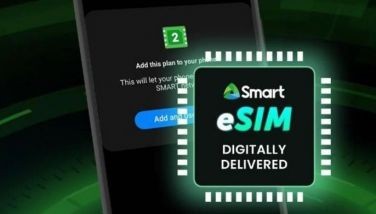Smartphones vs handhelds
May 21, 2005 | 12:00am
Move over handheld computers, smartphones are getting smarter and continue to win over the tech crowd and even mainstream buyers.
The Associated Press reported this week that shipments for handheld computers declined for the fifth straight quarter, according to data released by research firm International Data Corp. (IDC).
First quarter sales of handheld gadgets or personal digital assistants (PDAs), the IDC said, decreased by as much as 12.1 percent to only 1.9 million units compared to the same period last year, and dropped 30.6 percent in sales in the last quarter of 2004.
The steady plunge of PDAs in the global tech market was felt all throughout 2004 when overall sales for the year reached only 9.2 million units or 13 percent lower than 2003 sales of 10.6 million units.
During their sales peak in 2000 and 2001, PDAs were selling over 13 million units a year. This gradually went down to 12.1 million in 2002, 10.6 million in 2003 and 9.2 million in 2004.
In contrast, the sales of converged mobile devices such as smartphones that combine organizer functions and cellphone capabilities have steadily risen year-over-year, the IDC said.
In the first quarter this year, sales of smartphones jumped nearly 135 percent to 8.4 million units. In 2004, worldwide shipments reached around 27 million units, up 89 percent from 14.6 million units sold in 2003.
Just as sales of PDAs started its downhill drift in 2002 and 2003, smartphones’ rise in the sales charts started in 2003 and 2004, apparently picking up from where PDAs had left off.
The AP report quoted an IDC analyst as saying that "the handheld device market is facing stiff competition in saturated markets, while the converged mobile device market offers opportunities for new growth to handheld device and mobile vendors."
Handheld computers are pocket-sized devices that were designed as personal information management (PIM) gadgets. The world’s first PDA, a term coined by John Sculley, former chairman of Apple Computer Inc., was called Newton and at the time it was launched in 1993, it could store telephone numbers, notes and memos, had a digital calendar and could send and receive data.
The idea of a digital organizer did not pan out though until 1996 when the PalmPilot was launched by Palm Inc. The device was revolutionary as it was embraced by people on the go, business executives and tech enthusiasts in their first forays into a digital, wireless lifestyle.
In the Philippines, there was even a group of PalmPilot users dubbed Mapalad, a play on the Tagalog word for palm – palad.
The appeal of PDAs in the years before wireless LANs, notebook PCs, USB drives, and mobile phones is understandable.
In lieu of a bulky planner or filofax, here’s a gadget that can store all your information electronically – your calendar, meeting schedules and daily to-do-list, address book which keeps track and easily update your contacts, your notes and memos, and even your e-mails and e-mail contacts.
As PDAs evolved and as more companies went into the manufacture of handhelds, more functionalities were added such as games, music, movies, picture books, Bluetooth, and synchronization options with a desktop PC, a notebook or other handheld devices.
From the PalmPilot, other handhelds came from HP, IBM, Apple, Compaq, HP, Motorola, Sony, Dell, Asus and other manufacturers.
Then came the age of convergence.
When mobile handset manufacturers started incorporating camera, e-mail and PDA functions into the cellphone architecture, many saw PDAs seemingly riding into the sunset.
Mobile handset makers, especially Nokia and Research In Motion (RIM), maker of BlackBerry devices, cashed in on the emerging demand for converged devices, and furiously churned out gadgets that combined PDA functions with cellphone capabilities, or the coming together of voice and data capabilities in one device.
According to the AP report, Nokia led other handset makers in the first quarter sales of smartphones in 2005, with nearly 65 percent market share.
RIM, on the other hand was a far second with 9.2 market share. Catching up with RIM were Fujitsu, PalmOne and Sony Ericsson.
It was RIM, however, that made the first bold foray into the smartphone segment when it introduced the BlackBerry, a phone with e-mail capabilities, in the late 90s.
In 2005, the BlackBerry is more than just a phone and an e-mail device. It comes with a complete set of wireless connectivity solutions providing access to a host of wireless applications and devices. Its strength is seen in the enterprise, where most users are executives who use the BlackBerry to access e-mail from corporate servers.
Now, the Canadian software maker is facing a tough squeeze from all sides of the handheld market. The last few years saw a parade of mobile phones from Nokia Corp., Motorola Inc. and Samsung Electronics Co. with e-mail capabilities. These devices though were targeted more for consumers rather than the enterprise.
An article on silicon.com entitled "2009: When your phone becomes a Swiss army knife," bared a study from analyst house ARC Group showing a robust and sustained growth for smartphones until 2009.
Silicon.com also said that the ARC Group is predicting that "new data technologies will increasingly start to emerge on phones – GPRS, EDGE and 3G could well play a part – and helping to turn WAP into more of a popular mobile feature than a curiosity."
When Sony Corp. announced its plans to exit the PDA market in the US in June last year, many saw it as the beginning of the end for handheld computers, or if not a development that could hasten its demise. Toshiba Corp. followed suit in September 2004 when it announced that it was pulling out its handhelds, also in the US market.
There’s that segment though that views these pullouts from the conventional PDA market as an opportunity in disguise for handhelds. Maybe the PDA is not dying after all; it is merely evolving into a new form.
The IDC itself had said that there was an urgent need for PDA manufacturers to evolve their devices beyond personal information management.
The AP has reported that PalmOne Inc., maker of the highly successful PalmPilot, remained the top PDA seller in the first quarter of 2005, with a 33 percent share of the market. Hewlett-Packard was second, with 26 percent share, followed by Dell Inc. and Acer, with 11.4 percent and 6.5 percent shares, respectively.
These companies have not called it quits from the PDA line and have, in fact, continued evolving their handheld devices through the years.
PalmOne currently sells the Zire and Tungsten Palm OS-powered handhelds in Europe, North America, the Asia-Pacific, Latin America, Africa and the Middle East. The Zire line features MP3s, photos and video clips, while the Tungsten line is more known for its e-mail, Web and Internet capabilities.
PalmOne has also ventured into the smartphone category with its fast-selling Treo, which combines a phone, e-mail, messaging and Internet with a built-in camera, an MP3 player and Bluetooth technology.
HP, on the other hand, has its iPAQ pocket PCs for home and office use as well as for business. The iPAQ line carries digital photo album, Bluetooth and Wi-Fi technology, and media content streaming over a Wi-Fi network. Dell, too, has its Axim line of handhelds, and Acer, its N50 and N30 series.
In July 2004, PCWorld featured its top 10 PDA picks for the period and apart from these brands, it also included in its list the Toshiba Pocket PC E405 and the Sony Clie PEG-TH55 that were pulled out from the US market. Another brand that made it to the prestigious list was the Asus MyPal line of PDAs, which was marketed as "one device to replace all."
This handheld manufactured by Taiwanese company that also sells graphic cards, motherboards, networking products, notebooks, optical drives, and servers boast of a stylish design and is also high on entertainment features. The ASUS MyPal A716, for one, according to the Asus website, is also a road navigator, phone, radio, and digital camera.
Perhaps, the PDA is not really on the way to the graveyard, but is just in the process of redefining itself in a greatly changed tech milieu.
Only last week, Mobile Pipeline reported that the next mobile device that PalmOne is cooking will have a "built-in hard drive and support for Wi-Fi."
The gadget, dubbed as the LifeDrive Mobile Manager, has reportedly appeared on the listing of Amazon.com and is said to have also various media playback options.
The PDAs are far from over, while smartphones are just starting to carve their own narrative in the tech landscape.
The Associated Press reported this week that shipments for handheld computers declined for the fifth straight quarter, according to data released by research firm International Data Corp. (IDC).
First quarter sales of handheld gadgets or personal digital assistants (PDAs), the IDC said, decreased by as much as 12.1 percent to only 1.9 million units compared to the same period last year, and dropped 30.6 percent in sales in the last quarter of 2004.
The steady plunge of PDAs in the global tech market was felt all throughout 2004 when overall sales for the year reached only 9.2 million units or 13 percent lower than 2003 sales of 10.6 million units.
During their sales peak in 2000 and 2001, PDAs were selling over 13 million units a year. This gradually went down to 12.1 million in 2002, 10.6 million in 2003 and 9.2 million in 2004.
In contrast, the sales of converged mobile devices such as smartphones that combine organizer functions and cellphone capabilities have steadily risen year-over-year, the IDC said.
In the first quarter this year, sales of smartphones jumped nearly 135 percent to 8.4 million units. In 2004, worldwide shipments reached around 27 million units, up 89 percent from 14.6 million units sold in 2003.
Just as sales of PDAs started its downhill drift in 2002 and 2003, smartphones’ rise in the sales charts started in 2003 and 2004, apparently picking up from where PDAs had left off.
The AP report quoted an IDC analyst as saying that "the handheld device market is facing stiff competition in saturated markets, while the converged mobile device market offers opportunities for new growth to handheld device and mobile vendors."
The idea of a digital organizer did not pan out though until 1996 when the PalmPilot was launched by Palm Inc. The device was revolutionary as it was embraced by people on the go, business executives and tech enthusiasts in their first forays into a digital, wireless lifestyle.
In the Philippines, there was even a group of PalmPilot users dubbed Mapalad, a play on the Tagalog word for palm – palad.
The appeal of PDAs in the years before wireless LANs, notebook PCs, USB drives, and mobile phones is understandable.
In lieu of a bulky planner or filofax, here’s a gadget that can store all your information electronically – your calendar, meeting schedules and daily to-do-list, address book which keeps track and easily update your contacts, your notes and memos, and even your e-mails and e-mail contacts.
As PDAs evolved and as more companies went into the manufacture of handhelds, more functionalities were added such as games, music, movies, picture books, Bluetooth, and synchronization options with a desktop PC, a notebook or other handheld devices.
From the PalmPilot, other handhelds came from HP, IBM, Apple, Compaq, HP, Motorola, Sony, Dell, Asus and other manufacturers.
Then came the age of convergence.
When mobile handset manufacturers started incorporating camera, e-mail and PDA functions into the cellphone architecture, many saw PDAs seemingly riding into the sunset.
Mobile handset makers, especially Nokia and Research In Motion (RIM), maker of BlackBerry devices, cashed in on the emerging demand for converged devices, and furiously churned out gadgets that combined PDA functions with cellphone capabilities, or the coming together of voice and data capabilities in one device.
According to the AP report, Nokia led other handset makers in the first quarter sales of smartphones in 2005, with nearly 65 percent market share.
RIM, on the other hand was a far second with 9.2 market share. Catching up with RIM were Fujitsu, PalmOne and Sony Ericsson.
It was RIM, however, that made the first bold foray into the smartphone segment when it introduced the BlackBerry, a phone with e-mail capabilities, in the late 90s.
In 2005, the BlackBerry is more than just a phone and an e-mail device. It comes with a complete set of wireless connectivity solutions providing access to a host of wireless applications and devices. Its strength is seen in the enterprise, where most users are executives who use the BlackBerry to access e-mail from corporate servers.
Now, the Canadian software maker is facing a tough squeeze from all sides of the handheld market. The last few years saw a parade of mobile phones from Nokia Corp., Motorola Inc. and Samsung Electronics Co. with e-mail capabilities. These devices though were targeted more for consumers rather than the enterprise.
An article on silicon.com entitled "2009: When your phone becomes a Swiss army knife," bared a study from analyst house ARC Group showing a robust and sustained growth for smartphones until 2009.
Silicon.com also said that the ARC Group is predicting that "new data technologies will increasingly start to emerge on phones – GPRS, EDGE and 3G could well play a part – and helping to turn WAP into more of a popular mobile feature than a curiosity."
There’s that segment though that views these pullouts from the conventional PDA market as an opportunity in disguise for handhelds. Maybe the PDA is not dying after all; it is merely evolving into a new form.
The IDC itself had said that there was an urgent need for PDA manufacturers to evolve their devices beyond personal information management.
The AP has reported that PalmOne Inc., maker of the highly successful PalmPilot, remained the top PDA seller in the first quarter of 2005, with a 33 percent share of the market. Hewlett-Packard was second, with 26 percent share, followed by Dell Inc. and Acer, with 11.4 percent and 6.5 percent shares, respectively.
These companies have not called it quits from the PDA line and have, in fact, continued evolving their handheld devices through the years.
PalmOne currently sells the Zire and Tungsten Palm OS-powered handhelds in Europe, North America, the Asia-Pacific, Latin America, Africa and the Middle East. The Zire line features MP3s, photos and video clips, while the Tungsten line is more known for its e-mail, Web and Internet capabilities.
PalmOne has also ventured into the smartphone category with its fast-selling Treo, which combines a phone, e-mail, messaging and Internet with a built-in camera, an MP3 player and Bluetooth technology.
HP, on the other hand, has its iPAQ pocket PCs for home and office use as well as for business. The iPAQ line carries digital photo album, Bluetooth and Wi-Fi technology, and media content streaming over a Wi-Fi network. Dell, too, has its Axim line of handhelds, and Acer, its N50 and N30 series.
In July 2004, PCWorld featured its top 10 PDA picks for the period and apart from these brands, it also included in its list the Toshiba Pocket PC E405 and the Sony Clie PEG-TH55 that were pulled out from the US market. Another brand that made it to the prestigious list was the Asus MyPal line of PDAs, which was marketed as "one device to replace all."
This handheld manufactured by Taiwanese company that also sells graphic cards, motherboards, networking products, notebooks, optical drives, and servers boast of a stylish design and is also high on entertainment features. The ASUS MyPal A716, for one, according to the Asus website, is also a road navigator, phone, radio, and digital camera.
Perhaps, the PDA is not really on the way to the graveyard, but is just in the process of redefining itself in a greatly changed tech milieu.
Only last week, Mobile Pipeline reported that the next mobile device that PalmOne is cooking will have a "built-in hard drive and support for Wi-Fi."
The gadget, dubbed as the LifeDrive Mobile Manager, has reportedly appeared on the listing of Amazon.com and is said to have also various media playback options.
The PDAs are far from over, while smartphones are just starting to carve their own narrative in the tech landscape.
BrandSpace Articles
<
>
- Latest
Latest
Latest
February 22, 2024 - 3:17pm
February 22, 2024 - 3:17pm
December 28, 2023 - 12:00am
December 28, 2023 - 12:00am
December 11, 2023 - 11:00am
December 11, 2023 - 11:00am
November 23, 2023 - 4:35pm
November 23, 2023 - 4:35pm
October 16, 2023 - 5:00pm
October 16, 2023 - 5:00pm
Recommended



























